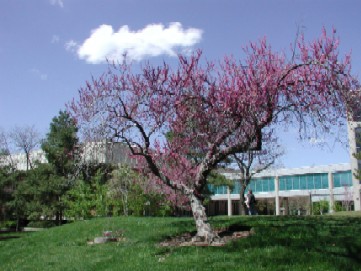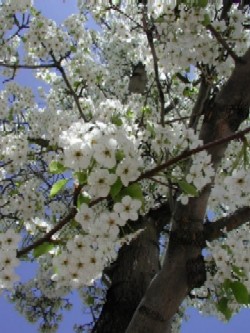
|
Vol.
12. No. 2
|
Fall
2002
|

The University of Utah's 9,500 campus trees are not only thought provoking but are also one of its most endearing features. They are daily reminders to book-weary students that seasons cycle on outside of the classroom.

So impressive are the
University's trees that in
1961 the Utah Legislature designated the U's collection, which covers
1,500 acres, and the assemblage of trees at Utah State University as the
state arboreta.
Today the U's grounds team prunes, maintains, and removes campus trees (though a preventative treatment program is beyond the reach of the U's resources).
The oldest trees on campus are the 90-year-old blue spruces (Picea pungens), just west of the Park Building, and the Siberian elms (Ulmus pumila), like those between the Student Services Building and the bookstore, which often volunteer on their own. An uncommon tree on campus is the evergreen southern magnolia (Magnolia grandiflora), located on the west side of Orson Spencer Hall (OSH) in the south cove. This is the same tree that surrounds the nation's capitol. Located west of Fort Douglas' Post Chapel is an unusual Osage orange (Maclura pomifera), another specimen not readily seen in Utah. Its pale green fruit (don't eat it!) is the size of an orange and looks like a brain. Only two rare Himalayan pines (Pinus wallichiana) reside on campus — on the north side of North Campus Road, behind the president's home, and on the central patio of Austin Hall. Their poetic design features holiday-perfect cones and long needles that grow in clumps of five. The needles' light stripes give the pine a feathery, light green color. When a breeze blows, every needle quivers. U of U arborist Ann Williams sums up the tree: "It's gorgeous."
Williams' other favorites include the incense cedars (Calocedrus decurrens), located on the south side of Milton Bennion Hall; the Chinese elms (Ulmus parvifolia) —not to be confused with the invasive Siberian elms — located by Cottam's Gulch and on the golf course; and the "interesting" Lavelle hawthorn (Crataegus x lavallei), located across from the Talmage Building on the grassy area of Presidents Circle. Williams describes this last tree as the most colorful in the fall and, with its its bright red fruit (a bird's feast), "the prettiest tree on campus in December."
 In
April, the trunks of the more common but showy eastern redbud trees (Cercis
canadensis) grow lavendar-pink blossoms that, from a distance, look
like purple moss. Several are located between the Aline Wilmot Skaggs
Biology Research Building and the Marriott Center for Dance. The flowering
pear (Pyrus calleryana) trees, located west of the Park Building,
exhibit brilliant colors in the fall and profuse white blossoms —
"popcorn" — in the spring.
In
April, the trunks of the more common but showy eastern redbud trees (Cercis
canadensis) grow lavendar-pink blossoms that, from a distance, look
like purple moss. Several are located between the Aline Wilmot Skaggs
Biology Research Building and the Marriott Center for Dance. The flowering
pear (Pyrus calleryana) trees, located west of the Park Building,
exhibit brilliant colors in the fall and profuse white blossoms —
"popcorn" — in the spring.
Dick Hildreth, former director of both the State Arboretum of Utah and Red Butte Garden and Arboretum, is especially fond of the University's group of very large European beech (Fagus sylvatica) trees, many of which grew on the land now occupied by the Olympic Village. But his particular favorite is the blue, "incredibly elegant," native single-needle piñon pine (Pinus cembroides var. monophylla), the only specimen on campus. To make way for the new George S. Eccles 2002 Legacy Bridge, the 15-foot tree was uprooted and transplanted in Red Butte's Children's Garden. It will take a couple more years to determine if it survived the transplant.
Mary Pat Matheson BS'81 MPA'93, former executive director of Red Butte Garden, lists the beech among her favorites as well — especially the one between the Sill Center and the Alumni House. "I love beeches because they grow slowly. When you see a mature one, with its gray, creamy bark, you know it's an old tree."
Of the trees in Red Butte Garden, Matheson especially admires the following: the dwarf conifer (many genera) collection, the grove of American sweet gum (Liquid ambar styracifula), the crab apple trees (Malus) that retain their fruit during the winter, and the growing collection of native Utah pines, including the bristlecone (Pinus aristata), piñon (Pinus edulis), limber (Pinus flexilus), and ponderosa (Pinus ponderosa).
Like Matheson, Williams confesses
that she has "tons" of favorite trees at the University. "It
would be a whole different campus if they weren't here," she notes.
![]()
—Ann Jardine Bardsley BA'84 is a writer in the U's public relations office.